“Am I Overly Suggestible?”: Liveness, Encounter, and the Relational in Contemporary Performance Art
Victoria Wynne-Jones
What is the role of liveness within cultures that are highly mediatized? If the digital screen, with its televisual experiences, is a mode of production that dominates all others, what does this mean for the category of cultural production that is live performance?1 Is it the case that the live and the mediatized continue to mutually define each other? And is it inevitable, as performance theorist Philip Auslander argues, that live performance, in its fight for survival, adopts the competitive strategy of becoming more and more like mediatized performance by incorporating technology? My hunch is that the liveness/mediatized distinction is something of a fiction. There can be no live events without employing technologies, tools, and conventions taken from histories of performing and fine arts, no matter how rudimentary an event may be. Additionally, isn’t liveness always-already mediatized through the materiality of bodies, languages, creative apparatus, and built environments? And the question remains, what is liveness? And what role does it play in contemporary performance art?
As a writer and performance art historian, I often wonder how to define liveness without resorting to what Auslander has called “clichés” and “mystifications” such as the “energy” that supposedly exists between performers and spectators in a live event, and the “community” that live performance is often said to create among performers and spectators.2 Yet as a performer I believe in all of these things. There is a palpable difference between rehearsing in an empty theatre and performing within a venue that is full to the rafters with people. Sometimes there are nights when everything feels off, the performers never quite hit their marks, rhythms become sluggish, and everything feels lacklustre. Sometimes no one turns up to the performance, and it happens anyway. Sometimes a group of spectators, collectively, all seem to be on the same page, deeply listening and supporting those who are performing, and they in turn feel lifted and perform better than they ever have. Their listening and attendance create an overwhelming sense of support that in turn energises the performer. Perhaps this is why some television sitcoms are still recorded in front of a live audience, such an energetic to-and-fro is particularly important when it comes to comedy. In this format, directors, writers, and actors can all get feedback in real time, working out timing, inflection, and what content actually works. Many televisual media continue to record live and there is a reason why most social media platforms also have the ability to stream live content.
The qualities that Auslander calls “cliché mystifications” are the very aspects of liveness and performance art that are the most interesting to me; what it is exactly that goes on between people, that which is inter-subjective or relational. Therefore, a question I often ask myself is: how might one curate artworks that interact with relational ontologies? What does an exhibition informed by research into intersubjectivity look or feel like? In a world that feels chaotic and apocalyptic, is exhibition-making a weak and futile endeavour? I tend to take an inquisitive, acquisitional, and accumulative approach to these questions. In place of Auslander’s “cliché mystifications,” here I employ the proposition of “subtle-bodies” as “a concept of the subject as composed of invisible, 'energetic' agency that interpenetrates and exceeds the physical body.”3 (Although, “subject” can be a problematic term, as it fails to differentiate bodies; a “so-called abstract, 'master subject' is normative, normate, specifically masculinist and racist, devoid of gender and ambiguous in terms of its historical situation.”4) Nonetheless, there is something to the idea of the agency of bodies that interpenetrates and is excessive, challenging individuation as well as the subject/object dualism. Throughout this piece, I will focus on agency on the level of what is felt or sensed—the perceived—that which is not normally visible such as atmosphere or breath. I am interested in the ways in which subtle bodies can be enacted rather than represented, as well as how subtle bodies in performance might disrupt relations that are hierarchical, grasping, proprietary, and anticipatory—relations that separate and isolate. Perhaps it is the spectre of separation and isolation that haunts much critique of heavily mediatized cultures.
In the spirit of challenging separation, theorists Geoffrey Samuel and Jay Johnston argued that one of the significant aspects of “subtle body language is the way in which it can open our picture of the individual out to include the relationship with others.”5 Johnston goes on to argue that “intersubjectivity is a term employed to signal the deep mutual imbrication of subjects" as well as their interdependence.6 Indeed, my own understanding of intersubjectivity is one that “takes as a starting point a recognition of embodied action as the basis for subjective life and that each subject is always-already enmeshed in interactions with others.”7 I can appreciate that this all seems very abstract… how exactly might these ideas be applied to contemporary performance art? In this piece, I will discuss these ideas in relation to performances that were included in the exhibition elbow-room in the universe, which I organised at Enjoy Contemporary Art Space in Te Whanganui-a-Tara Wellington in January 2020. The central premise, inspired by English philosopher Alfred North Whitehead, was that of making space or creating an environment that has room for irresponsibility and freedom. In the gallery this translated into creating slender openings in time-space so that visitors might find themselves in the midst of short and engaging interpersonal encounters.
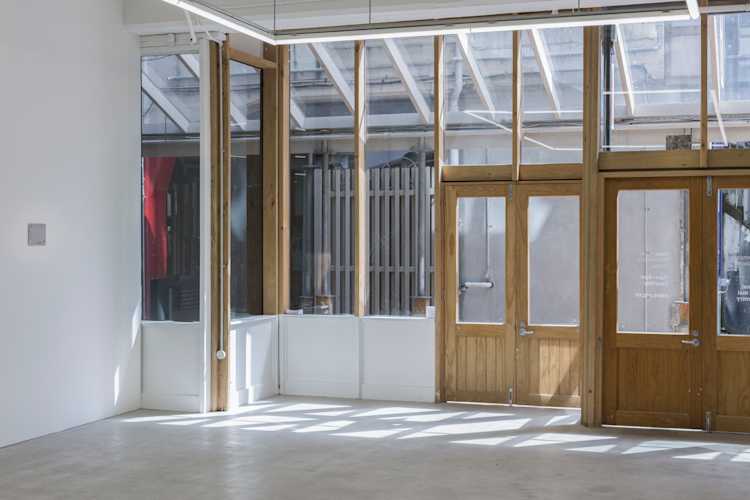
Pictured: Installation view, elbow-room in the universe, Enjoy Contemporary Art Gallery, Te Whanganui-a-Tara Wellington.
Photograph by Cheska Brown
As a curator who is also a performance art historian, I think a lot about how exhibition-making might engage with liveness and performance art. One aspect of elbow-room in the universe was a programme consisting of four performances that could be viewed by members of the public over four different days. With the exception of two works, which took place over a whole day, each work was performed in the evenings, leaving the question of what to do with a gallery space during its standard hours of 11am-6pm? I elected to include a so-called fifth performance, a suite of paintings by Naarm-based artist Fiona Williams. I have always considered Williams’ work to engage with ideas of liveness. Her practice is deeply attuned to changes in light and atmosphere, the way these shift and alter in an exhibition space throughout the day. Williams’ methodology recalls the way a gardener might observe where a cat sits within a garden, in order to understand where sun and warmth is at its optimum at different times of day. Before installing her work, Williams will spend a lot of time within the gallery space, working out where light falls at different times of the day and placing or hanging her works accordingly. As she paints in oil on aluminium, William’s works bear gestural marks that absorb and reflect the light and shadows of their surroundings. Throughout the duration of the exhibition, Williams’ paintings persisted, and the artist reflected “I’m like the rocks around the garden.” She wrote:
For this exhibition my paintings, like rocks, endured in the space while the other works appeared and disappeared each day. The paintings were placed in the space with consideration for how they would orient viewers/participants; respond to atmospheric conditions; be a surprise for someone working in the space (for instance the pieces in the library, or the one up high above the doorway); and also, how they might interact with the four performance pieces that would take place each day in the gallery. This positioning of the paintings drew attention to their temporal aspect. Participating in this exhibition developed my own understanding of the work as it exists in relation to others (whether this be other works, or other people/figures in the space), as well as making this aspect of the work really tangible for the first time in an exhibition.8
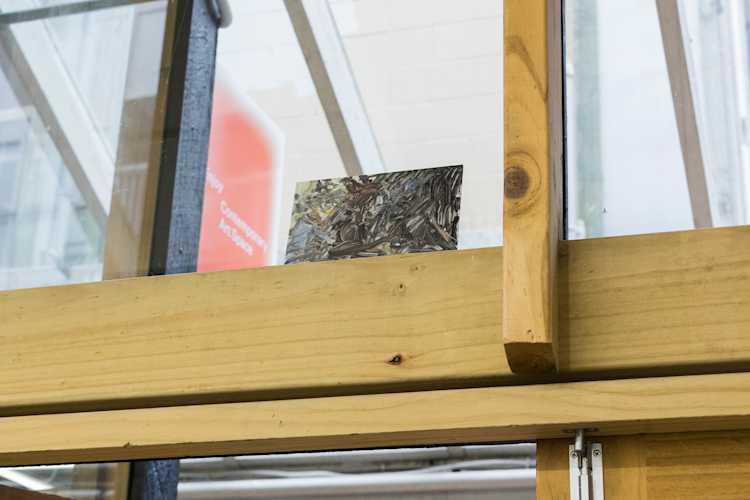
Pictured: Work by Fiona Williams in elbow-room in the universe, Enjoy Contemporary Art Gallery, Te Whanganui-a-Tara Wellington.
Photograph by Cheska Brown
Returning to the performances proper, on Friday 24 January, from 11am to 6pm, visitors encountered val smith's performance sexes on site - with light and air. For this work, smith was dressed head to toe in hi-vis protective gear, including earmuffs, sunglasses, and a helmet with visor and face mask. This attire felt ominous as it hinted towards a state of emergency; it also rendered smith genderless and unrecognizable. Throughout the day, they proceeded in an improvised and explorative way through the various spaces, the galleries, office, reading room, and kitchen, often leaving a trail of small road cones to indicate their movements. There was an incongruity between their costume and their subtle, gentle movements; they moved so slowly it was almost indetectable. Their slowness and silence made them seem oddly benevolent, but this belied the fact that smith was basically wearing full PPE for a substantial part of a summer's day.
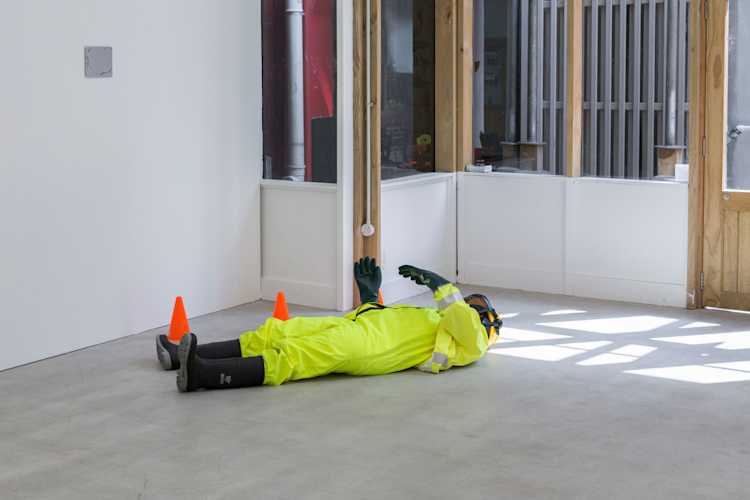
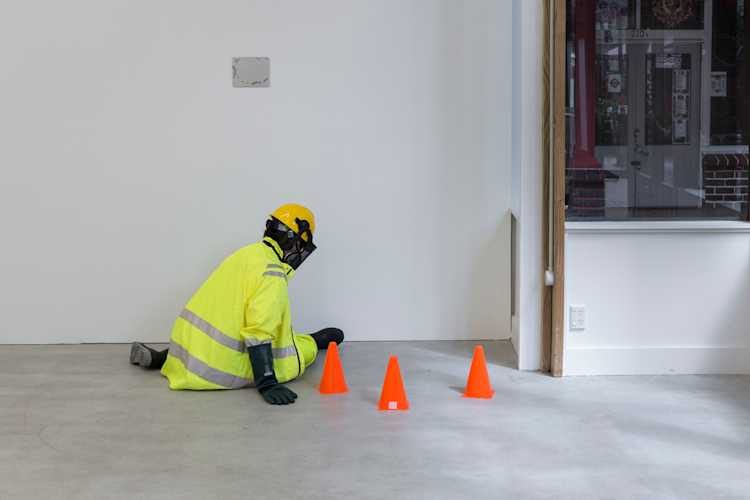
Pictured: val smith, sexes on site - with light and air, Friday 24 January 2020, 11am–6pm. Enjoy Contemporary Art Space, Te Whanganui-a-Tara Wellington. As part of the exhibition elbow-room in the universe, organized by Victoria Wynne-Jones.
Photographs by Cheska Brown
As an artist and choreographer, smith has a history of investigating urban sites and places as well as scrutinising the minutiae of micro-perceptions that time-spaces activated by a performance can enable. In sexes on site - with light and air, smith explored the immediate built environment by playfully adopting different positions, orientations, and perspectives. Above all, they seemed to be listening, though there was a tension between an ability to sense and the sensory deprivation caused by their protective clothing. smith reflects:
sensing the relations - listening to cracks, edges, crevices, through fleshy means, felt. taking time to form relationships with the light and movement of air, ever so gentle under doorframes or as someone moved past... light refracting, reflecting, sensorial impressions into body, allow the affect move me... really feeling the closeness/proximity and being open to that intimacy with concrete wall, table, microwave (its light deeply affected me) etc. more-than-human exchange, really at-tending to that with care and gentleness.9
Whether it was gazing at the warm light of an open microwave oven, or sitting at the threshold of the gallery and a nearby alley (one with a history of violent crime), experiencing sexes on site - with light and air was a witnessing of smith profoundly re-figuring their relationship with the material world and environment. Rather than “invisible forces,” smith's performance made manifest un-seeable operations of perceiving, felt sensation, or affect. As a “relational assemblage,” sexes on site - with light and air commingled and entangled performer, beholder, ambience, light, temperature, artificial lighting, the objects, and furniture of the art gallery.
Another way to describe this might be what poet and academic Lisa Samuels would call withness.10 Although originally intended to name a “sustained closeness” as part of an approach to interpretive reading, I feel like this idea of withness—designating an “event” or complex combination and interaction of artwork, context, and response—can also be applied to what smith enacts in this performance. Samuels writes that:
Withness turns away from potential power and distance stances of exegetical criticality and towards an attention with the engaged art event, an attention that does not seek to be somewhere other than in relation.
The kind of attention Samuels describes, that which is engaged and seeks to be in-relation, recalls a poem porcelain cabbages, read out aloud by Naarm-based artist Sholto Buck. At the opening event of the exhibition, as part of his contribution For a rainbow to be seen, the sun must be behind an observer who is facing falling rain, at 6pm on Wednesday 22 January, Buck’s contribution was a poetry reading. I quite enjoyed including this rudimentary and simple convention within a programme of performance art, particularly as it is a format that is often convoluted or complicated. When thinking about the myriad of events and formats that may be live, the poetry reading occupies a modest and timeless position. Many of Buck’s poems involve a close reading of his daily environment; he attends to being-in-relation with his surroundings, for example, looking into the window of a house during a bus ride. An extract of Buck’s porcelain cabbages follows:
Dear Homeowner,
I am writing to you as an admirer
of the porcelain cabbage
which sits in the square window
of the doorless brick wall of your house
It’s green and white
kind of a curved leaf
so it looks almost like a wave
trapped in the fibrous glaze
of its cabbageness
I love the porcelain cabbage
which sits in your window
and I want to tell you
that when I first saw it
around April of this year, I loved it especially
It used to sit
in the proud centre of your window
like the pale green eye
of a modernist cyclops
it was so enchanting!
But your porcelain cabbage no longer
has the middle spot
it’s been moved to the side
and replaced by a blankness
which I can only imagin
is the product
of the kind of restless indecision
which characterises many
small but ultimately profound changes
I go past your house on the bus sometimes
and keep an eye out
to see if you’ve moved it back
I’ve never sent an anonymous letter
I’ve never cared so deeply for porcelain
but there is something about the way
you keep the window empty
of anything but the cabbage
that makes me think you are someone
who cares about the emotional force
of aesthetic detail
Even though I don’t like it
in its current position
seeing the porcelain cabbage
in your window
when I go past on the bus
makes me smile
and gives me a resigned
Satisfaction
knowing that so much can be said
for the movement of approximately
one foot11
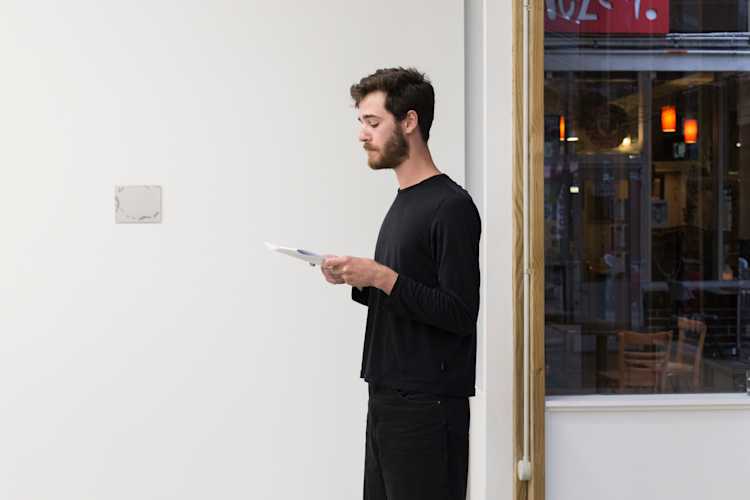
Pictured: Sholto Buck performing at the opening event for elbow-room in the universe, Enjoy Contemporary Art Gallery, Te Whanganui-a-Tara Wellington.
Photograph by Cheska Brown
This “staying-with” “hovers” in “generative egalitarian energies.” Samuels' “polydimensional image of attention involvement” was inspired by a cave, as described by philosopher Charles Saunders Peirce in his 1898 essay “Continuity.” In order to communicate the idea of “sensorily-transacted conceptual ongoingness,” and imagine a theory of continuity, he illustrates sensory continuity as haptic, olfactory, non-ocularcentric bubbles that cease to exist as finitudes when they're fully engaged. These caves are like filmy balloons, at turns dark, warm, and cool with alternating scents of neroli, lemon, and bergamot as well as frankincense, sandal-wood, cinnamon, and coffee.12
The interesting thing is that smith's improvisational engagement with site was contagious: in seeing them sense their way around, I could feel myself sensing too. I am reminded of Anne Boyer's description of sensing lambs:
The lamb knows how to read the quivering of each lamb nearby, how to become not one lamb but many lamb in the formation of lamb-like relation... The lamb knows how to read the feeling of the form of each other all together, the fears and pleasures and neutralities of each other, what is expressed in a bleat or twitch when the lamb is with the next one and there is never one lamb alone... The lamb knows how to read the motion of the air and knows the air's stillness. It knows the pattern of the bird of prey's flight, the slight shift in temperature resulting from the bird's shadow, the sound of the bird's cry overhead and the other sounds from which the bird's cry distinguishes itself.13
To encounter sexes on site - with light and air was to encounter smith enacting a kind of withness, a multi-modal attention involvement, as though their protective suit, like Peirce's Cave enabled them to make explicit the interpenetrating and excessive agency of feeling, sensing, and perceiving their surroundings. Through this performance, smith made explicit a point stated by human geographer Derek McCormack:
that affect is by no means confined or contained by the physical limit of bodies. Affect is instead better conceived of as a distributed and diffuse field of intensities, circulating within but also moving beyond and around bodies.14
Sonya Lacey's performance New light wedge fiction was performed on Saturday 25 January, during the gallery's opening hours of 11am to 4pm. This was a one-on-one performance in which one visitor at a time was invited to sit beside Lacey and listen to her read from a short script aloud. The text, written in the second person, together with the custom-made bench and the mode of delivery, evoked a kind of intimacy, perhaps even withness. Every time Lacey uttered the word “you” it felt as though she was talking about “you” the listener.
Do you think I'm asleep now? No. Am I overly suggestible? No ... well maybe a bit, sometimes in the afternoons.


Pictured: Sonya Lacey, New light wedge fiction, Saturday 25 January 2020. 11am–4pm. Enjoy Contemporary Art Space, Te Whanganui-a-Tara Wellington. As part of the exhibition elbow-room in the universe, organized by Victoria Wynne-Jones.
Photographs by Simon Gennard.
Written either during or slightly after her return from a residency in Singapore, the script situates the listener within a large, open-plan, white room. Lacey reflects “You'd know better but it's what I imagine every yoga studio looks like.” A bed, lamps, a vase of pussy willows, house plants, and a rattan lounge suite. There are air conditioning units and a ceiling fan.
For the occasion of New light wedge fiction, Lacey installed upon the gallery floor a large ceiling fan, so that when listening to the artist read aloud, one could watch the incongruous device swiftly rotating and feel transported to the space evoked by the artist's voice. Lacey admits “I get lost in biological problems” and goes on to discuss the various supplements she takes to aid sleep. “Zinc is said to aid slow-wave sleep, the nondreaming, deep sleep. Whatever this state is, inverted. It concentrates in muscle, bone, and in the liver, and if you build up adequate levels in the bloodstream it shortens the time it takes to fall asleep. It's good for plants too and although its leaves are green and show no sign of zinc deficiency, I dissolve some in the bougainvillea's water.”
It is here, in a tropical climate, within an air-conditioned room, watching Lacey share her supplements with a plant and reflecting on the nature of sleep that the text ends. Gazing at the ceiling fan rotating on the ground, I had the feeling of dwelling in two places at once and in a sultry space where humans and flowering plants take turns imbibing powdered metals. Through simple yet efficient means, Lacey temporarily refigures the relationship between self and environment, entangling, via voice and imagination, diverse geographies, flora, felt states, elements, and metals.
The ceiling fan is key as it swiftly circulates the air, activating what is usually invisible and sometimes made visible, in the rise and fall of a chest, an inflated balloon or wind stirring trees. As Lacey speaks and I listen, we share air between us, with the room, and the fan. This idea of “shared air” reiterates the way in which the not-normally-visible breath is one example of “energetic” agency that interpenetrates and exceeds physical bodies. Eco-philosopher David Abram has argued that “we rarely acknowledge the atmosphere as it swirls between two persons.” Returning to the idea of the mediatized, Abram argues that the ubiquity of overwhelming, mediated information, and viewing means that, more generally, there is a need for “remembering what is primary, and catching our breath.”15
Which brings me to my final question, is exhibition-making a futile endeavour? Abram asks:
What is climate change if not a consequence of failing to respect or even to notice the elemental medium in which we're immersed? Is not global warming, or global weirding, a simple consequence of taking air for granted?16
Abram goes on to argue that one way to begin to respect the atmosphere and air, to “renew our participation in the more-than-human community—in the breath commons—” is “by telling stories.” Stories “that we tell aloud, face to face, sharing the same air with those who listen.”17 It is this very premise that this exhibition was built upon.
I am grateful to Abram for his proposition that live acts of telling stories aloud, face-to-face, sharing air, in the hopes that acknowledging atmosphere and renewing participation in the breath commons as a more-than-human community, are a small step in combatting ways of thinking, being and doing that have contributed to the current climate crisis. This brings me to another performance as part of elbow-room in the universe, a work titled Have you ever felt overwhelmed? The words of climate scientists, activists, and journalists by New York City-based artist Amy Howden-Chapman. Taking place at 6.30pm on Thursday 23 January, the performance involved a group of people reading a text aloud to a gathered audience. If visitors came into the gallery during the day on that Thursday, they would have seen nine folding chairs in a circle. For the performance proper, Howden-Chapman’s “readers” made up of family members and friends each sat on one of these chairs. Additional circles of chairs were set up around the first, like ripples in a pond, and some audience members could be seated on these, the rest of those stood, gathered behind them. In this “mass-reading,” each of the speakers took turns reading aloud parts of Howden-Chapman’s script. The script was drawn from transcripts of interviews with climate physicists, economists, activists, and journalists. As the reading proceeds, it generates a kind of chorus of grief and ambition that coalesce into a call for greater reflection on the drivers of the climate crisis along with action to diminish its danger. An extract from the script follows:
We’re not ever going to solve climate change by just solving climate change. Climate change is a symptom of other things that are out of balance, so understanding how it’s connected to those other systems is really the first step before doing anything. Natasha Myers says, Let go of the logic of capitalism, let go of the idea that what you think is common sense is actually common sense. Be courageous and think about what a world you actually want will look like... People need to actively create the kind of world they want to live in. And it’s a really desperate and heart-breaking world that we are living in right now, because I think from 2020 on will be the decade of reckoning and the decade of grief, but also a decade of action.18
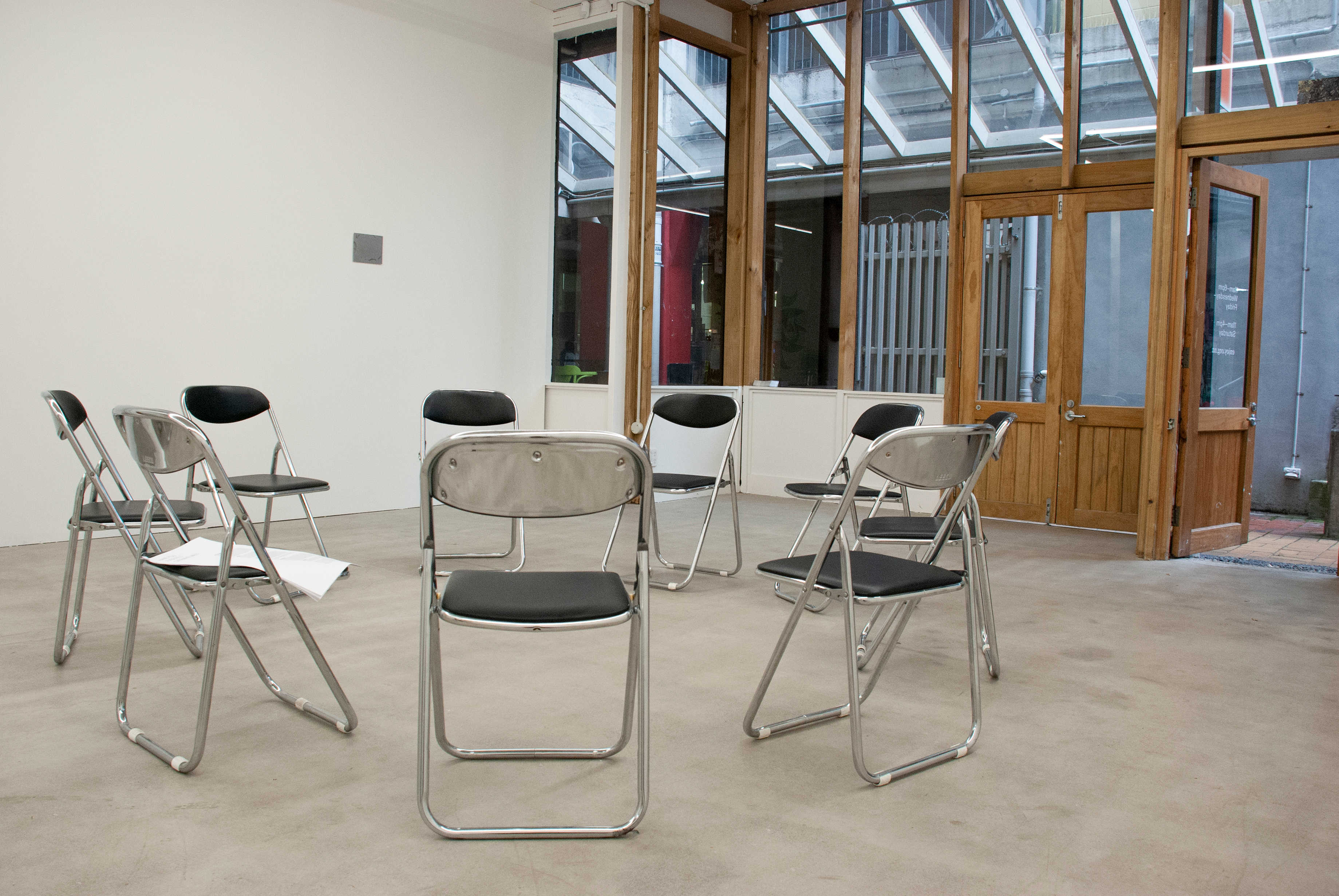
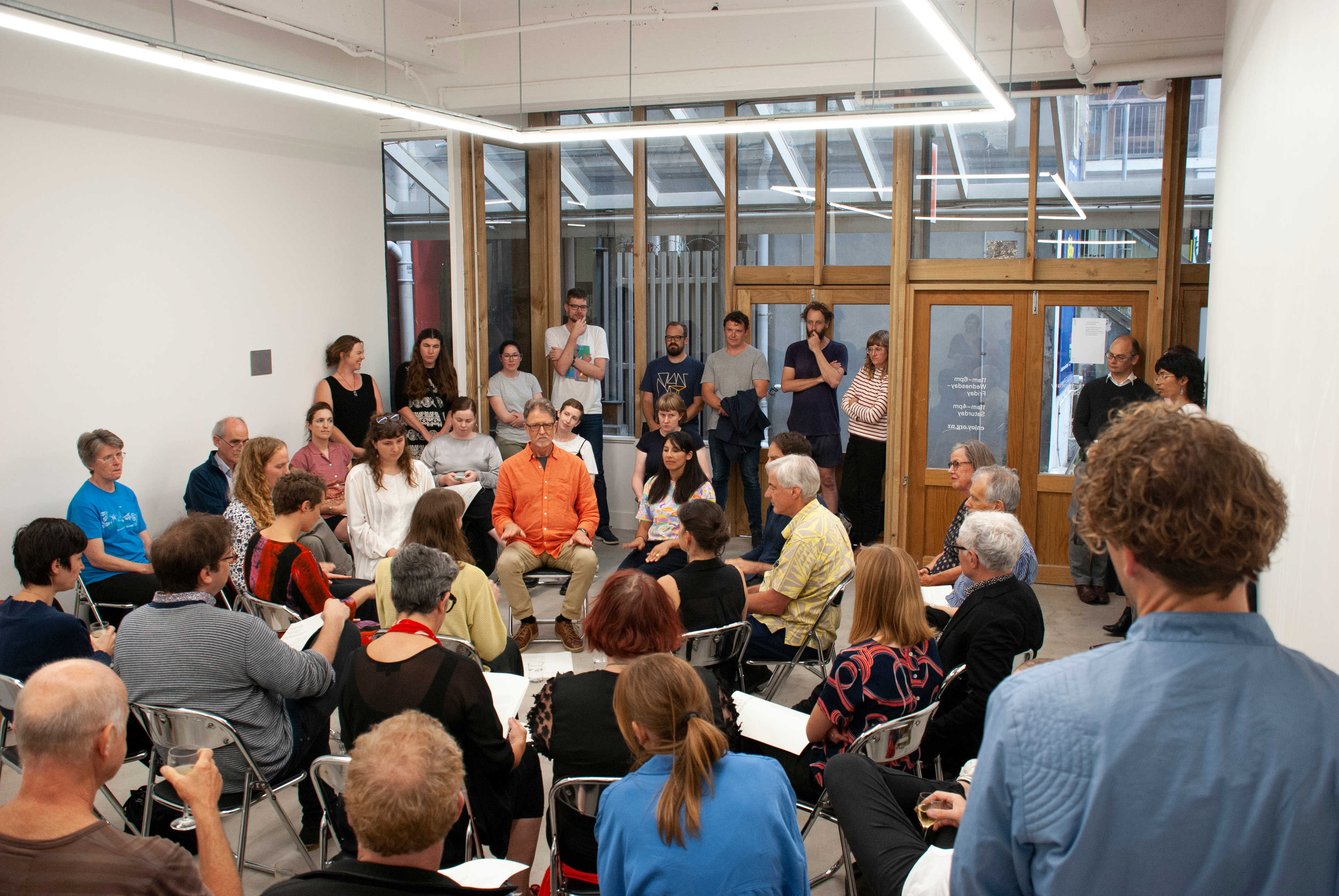
Pictured: Amy Howden-Chapman, Have you ever felt overwhelmed?, Thursday 23 January 2020. Enjoy Contemporary Art Space, Te Whanganui-a-Tara Wellington. As part of the exhibition elbow-room in the universe, organized by Victoria Wynne-Jones.
Photographs by Simon Gennard.
In an interview, philosopher Gilles Deleuze surmised that “Making an event—however small—is the most delicate thing in the world.”19 And it is these words that I often think of when facilitating performance artworks. However small and delicate, I still believe they hold a special power. This is echoed by theorist Kai van Eikels who has posited that art “as an occasion for things to be practised... can be a medium for a weak political power.”20 Perhaps art’s very virtue is its “strategic weakness.” For literary theorist Rodolphe Gasché, relations are “minimal things,” though they can be small and almost elemental, they are also “the most basic and simple of all philosophical problems.”21 I believe that curating relational performances is one way of examining philosophical problems, perhaps even, as Abram would argue, the existential problem of the climate emergency. Closer to home, Naarm-based writer Tom Melick points out “The most delicate things are always responding to, and rephrasing, the most powerful, and in that process gain a different kind of power.”22
References
Abram, David. "The Commonwealth of Breath." In Atmospheres of Breathing, edited by Lenart Škof and Petri Berndtson, 263-276. Albany, NY: SUNY Press, 2018.
Auslander, Philip. Liveness: Performance in a Mediatized Culture. London and New York: Routledge, 2023.
Berardi, Franco Bifo. Breathing: Chaos and Poetry. South Pasedena, CA: Semiotext(e), 2018.
Boyer, Anne. A Handbook of Disappointed Fate. Brooklyn, NY: Ugly Duckling Presse, 2018.
Carter, Susan. "The methodology of magpies." International Journal of Research & Method in Education 37, no. 2 (2014): 125-136.
Deleuze, Gilles and Parnet, Claire. Dialogues, trans. Hugh Tomlinson and Barbara Hammerjam. New York: Columbia University Press, 1987.
Johnston, Jay. "Subtle subjects and ethics. The subtle bodies of post-structuralist and feminist philosophy." In Religion and the Subtle Body in Asia and the West, edited by Geoffrey Samuel and Jay Johnston, 239-248. Abingdon, Oxon; New York: Routledge. 2013.
McCormack, Derek P. Refrains for Moving Bodies: Experience and Experiment in Affective Spaces. Durham and London: Duke University Press, 2013.
Peirce, Charles Sanders. "The Logic of Continuity." In Reasoning and the Logic of Things, edited by Kenneth Laine Ketner, 242-268. Cambridge; London: Harvard University Press, 1992.
Melick, Tom. "Homework for Love and Trouble" in Snack Syndicate, Homework. Melbourne: Discipline, 2021.
Sabisch, Petra. Choreographing relations : practical philosophy and contemporary choreography: in the works of Antonia Baehr, Gilles Deleuze, Juan Dominguez, Félix Guattari, Xavier Le Roy and Eszter Salamon. München: epodium 2011.
Samuel, Geoffrey and Johnston, Jay. "General introduction." In Religion and the Subtle Body in Asia and the West, edited by Geoffrey Samuel and Jay Johnston, 1-9. Abingdon, Oxon; New York: Routledge. 2013.
Samuels, Lisa. "Membranism, wet gaps, archipelago poetics." Reading Room 4 (2010): 156-167.
Samuels, Lisa. "Withness in kind." Performance Paradigm 16 (2021): 60-73.
Škof, Lenart and Berndtson, Petri. Atmospheres of Breathing. SUNY Press, Albany NY, 2018.
van Eikels, Kai. "From 'Archein' to 'Prattein': Suggestions for an Un-creative Collectivity." In Rehearsing Collectivity: Choreography Beyond Dance, edited by Elena Basteri, Emanuele Guidi and Elisa Ricci, 5-19. Berlin: argobooks. 2012.
van Gelder, Pia and Johnston, Jay. "Invisible Forces: Subtle Bodies In and Around Works of Art" Call for papers, IMPACT: AAANZ Conference Sydney, June 2021. https://aaanz.info/aaanz-home/conferences/2021-conference-impact/call-for-papers/.
Wynne-Jones, Victoria. Choreographing Intersubjectivity in Performance Art. Cham, Switzerland: Palgrave Macmillan. 2021.
Notes
1
See Philip Auslander, Philip. Liveness: Performance in a Mediatized Culture. (London and New York: Routledge, 2023), 2-3.
2
Auslander, Liveness, 3.
3
Pia van Gelder and Jay Johnston, "Invisible Forces: Subtle Bodies In and Around Works of Art" Call for papers, IMPACT: AAANZ Conference Sydney, June 2021. https://aaanz.info/aaanz-home/conferences/2021-conference-impact/call-for-papers/.
4
Victoria Wynne-Jones, Choreographing Intersubjectivity in Performance Art. (Cham, Switzerland: Palgrave Macmillan, 2021), 16. These criticisms come from Judith Butler's feminist critique of Merleau-Ponty (1989).
5
Geoffrey Samuel and Jay Johnston, "General introduction." In Religion and the Subtle Body in Asia and the West, edited by Geoffrey Samuel and Jay Johnston, 1-9. *Abingdon, Oxon; New York: Routledge, 2013), 6.
6
Jay Johnston, "Subtle subjects and ethics. The subtle bodies of post-structuralist and feminist philosophy." In Religion and the Subtle Body in Asia and the West, edited by Geoffrey Samuel and Jay Johnston, 239-248. (Abingdon, Oxon; New York: Routledge, 2013), 241.
7
Wynne-Jones, Choreographing Intersubjectivity in Performance Art, 19.
8
Fiona Williams, communication with the author, 16 June 2020.
9
val smith, communication with the author, 8 December 2021.
10
Lisa Samuels, “Withness in kind.” Performance Paradigm 16 (2021): 60.
11
Sholto Buck, communication with the author, 14 January 2020.
12
Charles Saunders Peirce, “The Logic of Continuity.” In Reasoning and the Logic of Things, edited by Kenneth Laine Ketner, 242-268. (Cambridge; London: Harvard University Press, 1992), 252.
13
Anne Boyer, A Handbook of Disappointed Fate. (Brooklyn, NY: Ugly Duckling Presse, 2018), 18-19.
14
Derek P. McCormack, Refrains for Moving Bodies: Experience and Experiment in Affective Spaces. (Durham and London: Duke University Press, 2013), 3.
15
David Abram, "The Commonwealth of Breath." In Atmospheres of Breathing, edited by Lenart Škof and Petri Berndtson, 263-276. (Albany, NY: SUNY Press, 2018), 272.
16
Abram, 263.
17
Ibid., 273.
18
Amy Howden-Chapman, Have You Ever Felt Overwhelmed? Performance script, 2020.
19
Gilles Deleuze and Claire Parnet, Claire. Dialogues, trans. Hugh Tomlinson and Barbara Hammerjam. (New York: Columbia University Press, 1987), 66.
20
Kai van Eikels, "From 'Archein' to 'Prattein': Suggestions for an Un-creative Collectivity." In Rehearsing Collectivity: Choreography Beyond Dance, edited by Elena Basteri, Emanuele Guidi and Elisa Ricci, 5-19. (Berlin: argobooks, 2012), 19.
21
Rodolphe Gasché quoted in Petra Sabisch, Choreographing relations : practical philosophy and contemporary choreography: in the works of Antonia Baehr, Gilles Deleuze, Juan Dominguez, Félix Guattari, Xavier Le Roy and Eszter Salamon. (München: epodium 2011), 72.
22
Tom Melick, "Homework for Love and Trouble" in Snack Syndicate, Homework. (Melbourne: Discipline, 2021), 16.
Victoria Wynne-Jones is a curator and art historian based in Tāmaki Makaurau. Her research interests include: intersections between performance art history and dance studies, contemporary art theory and philosophy, curatorial practice and feminisms. Her monograph Choreographing Intersubjectivity in Performance Art was published by Pagrave Macmillan in 2021.
